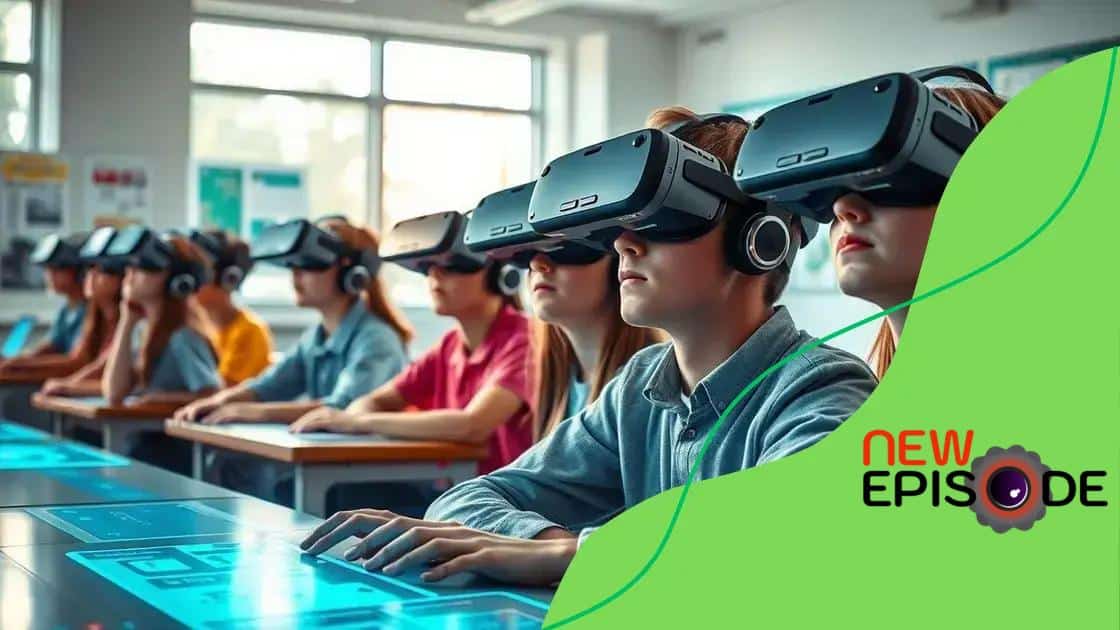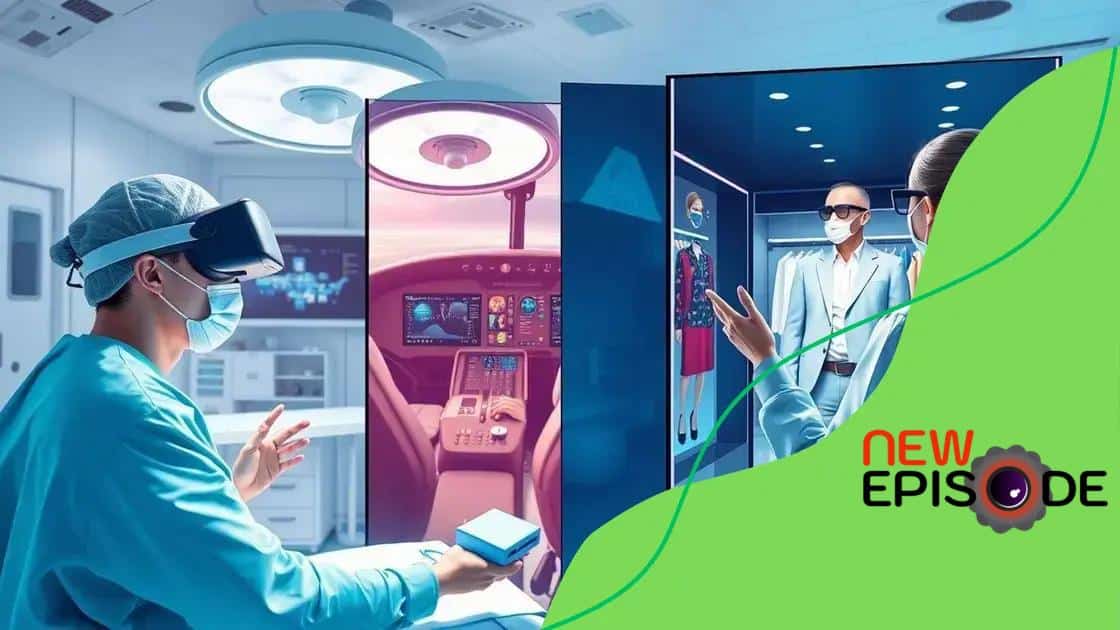Virtual reality in the classroom: Transforming education

Virtual reality in the classroom enhances student engagement and learning through immersive experiences, personalized education, and practical applications, preparing students for future careers while overcoming challenges like cost and training.
Virtual reality in the classroom is reshaping how educators teach and students learn. Imagine stepping into a historical event or exploring the human body in 3D, making lessons not just informative but unforgettable. Curious about how this transformation is happening? Let’s dive in!
Understanding virtual reality technologies
Understanding virtual reality technologies is crucial for educators looking to innovate their teaching methods. By incorporating these technologies, teachers can create immersive learning experiences that capture students’ attention and enhance their understanding of complex subjects.
Virtual reality (VR) allows students to explore environments that would be impossible or impractical to visit in real life. For example, they can walk through ancient ruins or observe scientific phenomena up close. This level of engagement can lead to deeper learning.
Key Components of Virtual Reality
There are several key components that make up virtual reality systems:
- Head-mounted displays (HMDs): Devices worn on the head that provide a 360-degree visual experience.
- Motion tracking: Technology that senses the user’s movements, allowing them to interact naturally with the VR environment.
- Controllers: Handheld devices that let users manipulate objects in the virtual world.
- Audio: Immersive sound effects that complement the visual experience, adding to realism.
These technologies are already being utilized in various educational settings. For instance, in *science classes*, students can use VR to conduct virtual experiments. In *history lessons*, they can take virtual tours of historical sites.
Furthermore, the use of VR can cater to different learning styles. Visual learners benefit from seeing phenomena in 3D, while kinesthetic learners enjoy interacting with the technology. There are also opportunities for collaborative learning as students can experience shared virtual spaces together.
Applications in Education
Several educational institutions are integrating virtual reality into their programs:
- Medical training: Students can practice surgeries in a safe, controlled environment.
- Language learning: VR can immerse students in different cultures, enhancing language acquisition.
- Environmental studies: Simulations can show the impact of climate change directly in the classroom.
By implementing these technologies, educators can create meaningful learning experiences that resonate with students, making education not just informative but also exciting.
Benefits of virtual reality in education
The benefits of virtual reality in education are vast and transformative. By providing immersive experiences, VR engages students in ways that traditional teaching methods often cannot. This technology not only enhances engagement but also improves retention of information.
One of the most significant advantages is the ability to create experiential learning opportunities. For example, students can virtually visit the surface of Mars or dive into the depths of the ocean. These experiences foster curiosity and motivate learners to explore subjects more deeply.
Enhanced Engagement and Motivation
When students interact with learning material through VR, their motivation increases. The immersive nature of virtual environments captures their attention and stimulates learning. They are often more willing to participate when the lesson feels more like an adventure.
- Interactive experiences: Students can manipulate virtual objects and environments.
- Realistic scenarios: VR can simulate real-world problems and situations.
- Collaborative learning: Students can explore virtual worlds together, encouraging teamwork.
Another remarkable aspect is the personalization of learning. VR can cater to different learning styles, allowing for visual, auditory, and kinesthetic engagement. Students can learn at their own pace, revisiting challenging concepts in a more accessible and engaging format.
Improved Retention and Understanding
Research shows that students who learn through VR retain information better than those who learn through traditional methods. The combination of visual and tactile experiences aids in memory formation. This is particularly beneficial for complex subjects such as science and history.
- Active learning: Engaged students are more likely to remember what they learn.
- Emotional connection: Immersive experiences create lasting impressions.
- Critical thinking: Virtual challenges encourage students to solve problems creatively.
With these benefits, virtual reality has the potential to revolutionize education. Schools that adopt VR technologies can offer students unique learning experiences that prepare them for the future.
Real-world applications of virtual reality tools

The real-world applications of virtual reality tools are expanding rapidly, transforming many sectors, including education and training. These technologies provide hands-on experiences that are both safe and effective. Educators can use VR to simulate real-life situations that are relevant to students’ futures.
In the field of medicine, for example, medical students can practice surgeries using VR simulations. This method allows them to gain experience without risking patient safety. They can make mistakes and learn from them in a controlled environment, which builds confidence and skill.
Training and Simulation
Industries are increasingly utilizing VR for training purposes. Employees can access immersive modules that prepare them for actual job scenarios.
- Aviation: Pilots use flight simulators to practice emergency procedures.
- Construction: Workers train in virtual environments that mimic real construction sites.
- Emergency Response: First responders can engage in realistic simulations of disaster scenarios.
This hands-on approach enhances understanding and retention, which traditional methods may lack. Trainees gain a deeper insight into their roles and responsibilities while practicing skills crucial for their success.
Virtual Reality in Retail and Marketing
Another exciting application of VR is in retail and marketing. Companies are adopting VR to enhance customer experiences. Shoppers can explore stores virtually from the comfort of their homes. This feature allows them to visualize products in their space before making a purchase.
- Virtual try-ons: Customers can see how clothes look on them without physically trying them on.
- Product demonstrations: VR can showcase how a product works in a realistic setting.
- Interactive branding: Brands can create engaging virtual experiences that resonate with customers.
As these applications illustrate, virtual reality tools are becoming invaluable across various industries, paving the way for innovative solutions that enhance learning, training, and customer engagement.
Challenges in implementing virtual reality in classrooms
Implementing virtual reality in classrooms comes with distinct challenges that educators and institutions must navigate. While the benefits are substantial, these obstacles can hinder effective integration.
One of the primary concerns is the cost associated with acquiring VR technology. From purchasing headsets to software and maintenance, expenses can quickly add up. Schools with limited budgets may struggle to provide enough resources for all students. This raises questions about equity in access to technology.
Technical Issues and Training
Another challenge is the technical skills needed to operate VR equipment. Teachers may require additional training to feel comfortable using these technologies in their lessons. Proper training ensures that educators can help students make the most of their VR experiences.
- Equipment maintenance: Ensuring that the technology works properly requires ongoing upkeep.
- Software updates: Keeping software current can be time-consuming and complex.
- Technical support: Schools need to have resources available for troubleshooting issues.
The physical space in classrooms is also a consideration. VR activities often require sufficient room for students to move around safely. Classrooms that are too small may not provide an effective learning environment for immersive experiences. Additionally, teachers must manage the classroom while allowing some students to explore the VR environment independently.
Student Readiness and Engagement
There may also be concerns about student readiness for VR learning. Not all students will respond positively to VR experiences, and some may feel disoriented or overwhelmed. Teachers need to gauge individual student comfort levels and readiness before implementing VR lessons.
- Varied learning styles: Some students may not engage with VR as well as others.
- Digital distractions: VR environments might distract some students from the learning objectives.
- Physical discomfort: Extended use of VR headsets can cause discomfort or motion sickness.
By addressing these challenges, educators can pave the way for a more effective integration of virtual reality in their classrooms, enhancing the educational experience for all students.
The future of education with virtual reality
The future of education with virtual reality promises to be revolutionary, reshaping how students learn and interact with knowledge. As technology advances, VR will become more accessible, opening new doors for immersive education experiences.
One key aspect of this future is the potential for personalized learning. With VR, educational content can cater to individual learning styles. Students can engage with materials that match their interests and pace, enhancing their overall learning experience.
Increased Collaboration and Engagement
Another exciting development is the increased collaboration VR can foster among students. Virtual environments allow learners from different locations to work together on projects in real-time. This collaborative aspect helps students develop teamwork skills while engaged in their education.
- Global classrooms: Students can interact with peers and teachers from around the world.
- Real-life simulations: Group projects that mimic real-world challenges can be tackled collectively.
- Shared experiences: Students can embark on virtual field trips together, making learning more engaging.
Moreover, as VR integrates with other technologies, such as artificial intelligence, the possibilities expand even further. AI can provide real-time feedback and support, enhancing the effectiveness of the virtual learning environment.
Broadening Career Preparation
In addition, virtual reality will play a crucial role in career preparation. Students can gain valuable hands-on experience in various fields through simulated environments. This experience equips them with the skills needed for future jobs.
- Job-specific training: Students can practice in safe environments relevant to their desired careers.
- Skill development: VR can focus on developing soft skills needed for the workplace.
- Industry partnerships: Schools can collaborate with businesses to create relevant VR training experiences.
By embracing virtual reality, educators can create a more engaging, inclusive, and effective learning environment that prepares students for success in an increasingly complex world.
FAQ – Frequently Asked Questions about Virtual Reality in Education
What are the main benefits of using virtual reality in the classroom?
Virtual reality enhances student engagement, allows for personalized learning experiences, and enables hands-on simulations of real-world scenarios.
What challenges might schools face when implementing VR technology?
Schools may encounter high costs, the need for technical training, limited classroom space, and varying student readiness.
How does virtual reality promote collaboration among students?
VR allows students to interact and work together in virtual environments, enabling them to develop teamwork skills while deepening their learning.
In what ways can VR prepare students for future careers?
VR provides practical, hands-on training experiences that are directly relevant to various career paths, helping students gain essential skills.






